Friends of the Osprey Telemetry Project
The Friends of the Osprey in conjunction with Bird Studies Canada had a project using Telemetry to track and record the migration habits of a female osprey over the winter months for two years. We were fortunate to be able to put devices on two females. We lost one the first winter, but tracked the other for a further two years.
Osprey Tracking
Bird Studies Canada was partnering with the Friends of the Osprey in the Kawartha Lakes region of Ontario to track the migration of adult Ospreys. In May 2010, two nesting adult female Ospreys were fitted with solar-powered satellite transmitters. The transmitters were attached to the Ospreys using a backpack-style harness made of neoprene and Teflon.
The objectives of this project were to determine the migratory routes and wintering areas of Ospreys from the Kawartha Lakes region. Locations were received every two days and will be displayed on Bird Studies Canada’s Osprey Tracker site once the birds begin their migration.
Osprey Positions
2013
August 2013
Well we were almost at the point of believing warm weather was never going to come to southern Ontario but it finally did.
Our bird returned as well to the general area of Sturgeon Lake but on May 4th the transmitter stopped sending a signal. Initially we thought that she was still out there somewhere but after consultation with Bird Studies Canada and Northstar we have come to the unfortunate conclusion that she might have died.
Last year she exhibited some very bizarre behaviour and didn’t nest. She ended up on Lake Simcoe but was never seen by anyone. She did cover her migration route from the previous year and travelled to basically the same area in South America. There is a strong possibility that she was an old bird because of the actions she exhibited last year.
I personally want to thank all those involved with the project. It took a lot of work and dedication. We succeeded in gathering the data we wanted over the past two years. Sadly though, I just learned that Debbie Badzinski, our Bird Studies Canada contact, is leaving for a new job in August. Debbie has been very helpful over the years helping us with the telemetry project and coordinating the data with the mapping. I know we all wish her the best in her new endeavour.
2012
Our tagged Osprey, 54706 has finally reached back to the Kawartha Lakes. Our latest coordinates (44.378, -79.248 on June 26, 2012) showed her hanging around Georgina Island on Lake Simcoe.
This is one weird bird. She goes so far south and takes so long to come back. I wondered if she is a very old bird in that she is so slow and also she doesn’t wander all winter, feeding within one square mile. She did everything late last year and raised 2 chicks. She was even later this year. The plan was that we would again entrap her for a moment and remove the telemetry harness. She has given us valuable data. I didn’t know of any study showing an osprey going so far south of the equator.
However, we had a discussion with Prof. Rob Bierregaard from the The Department of Biology University of North Carolina at Charlotte, and he said it wasn’t unusual for a female osprey to take a break from mating and wander around for a year (a break year). Which could be what our Osprey is doing this year.
He also explained that he has had a bird go as far south as we have, and it is an exception to the general rule, but not unheard of.
As for the transmitter. We cannot remove it this year without a nest for her to be protecting, as this is how we trapped her in the first place. He explained that he has never taken off a transmitter and they have no effect whatsoever on the health or behaviour of any of the birds he has studied.
We will continue to pay for the transmission reports for the foreseeable future and we will track her movements. Perhaps in another year we will be able to remove the transmitter if she settles down on a nest, but we are happy to report that in the meantime it isn’t affecting her adversely.
Simon
2011
During the winter, one of our birds seemed to have stalled near Cuba and we were concerned as to what had happened. Bird Studies Canada informed us that the disappearance of one of our birds could be due to mortality or damage to the transmitter. They have also seen cases where a transmitter blinked off for several months, then mysteriously blinked back on again. … We’ll have to wait and keep our fingers crossed.
The Osprey that has the transmitter that is still sending out signals has made her way back to the Kawartha Lakes. We are still looking out to see if we can spot the other femail Osprey to find out if it is just her tracker that failed, rather than a mortality.
This was one of the reasons we made the decision to have two birds tagged, and we hope that in the next while, the second bird’s transmitter will start up again.
Overview of the Bird’s Route South and Back
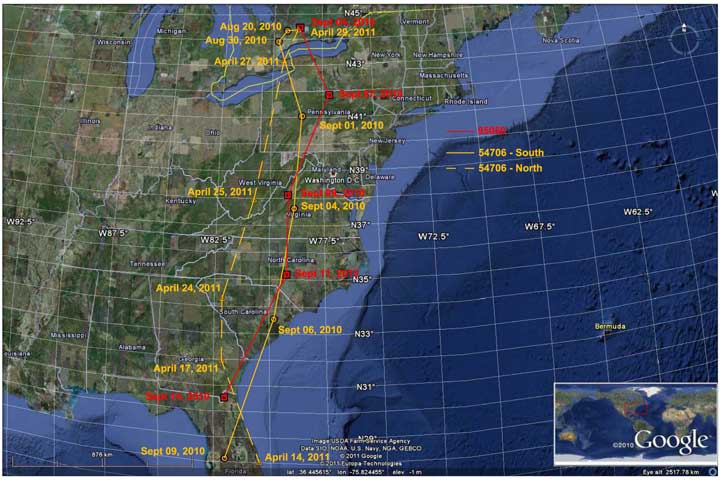
This is the route of the two birds took while in North America. The red colour is bird number 95050, the bird we have lost track of. The yellow lines are bird number 54706. The solid line is the route south, and the dashed line is the route back.
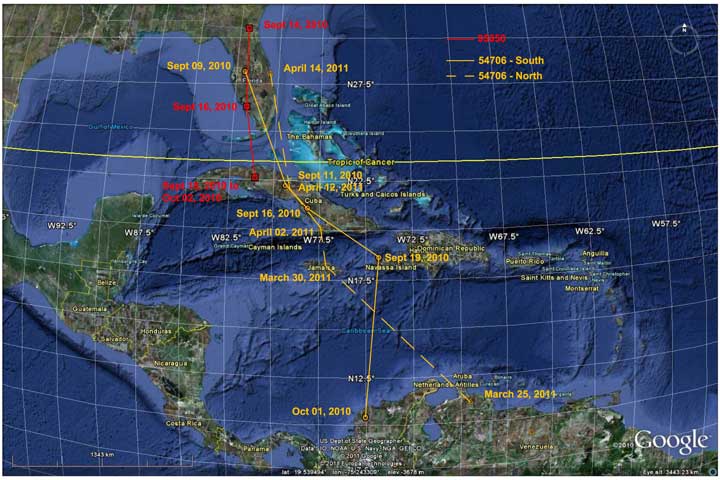
This is an image of the route down past Florida, through Cuba and then into South America.
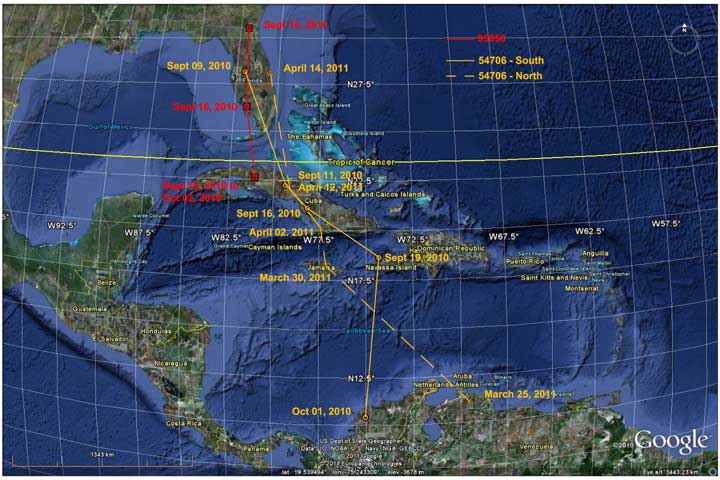
This is the route and dates that bird 54706 was in South America.
Thank you to Greg Chappel, for creating these maps with Google Earth that illustrate the route quite clearly.
Bird Studies Canada and Friends of the Osprey gratefully acknowledge the support of the following funders: Ontario Ministry of Natural Resources, The Lindsay Post, Osprey Media, Georgian Bay Osprey Society, Hydro One, Lunge Haven Cottages, Bushnell, Kawartha Spirit Boat Cruises, Kawartha Lake Classic Flowers, the City of Kawartha Lakes, and Shell Environmental Fund.
But what is Telemetry?

It is a process of tracking the movement of birds or animals in their day to day activities. A small transmitter PTT (Platform transmitter terminals) weighing 14 grams is placed on the bird or animal and a signal is sent to a satellite in space. The company being used for this project is North Star. North Star uses the Argos Satellite system. The Argos System is a polar orbiting, LEO constellation of French-owned receivers. Mounted on five US weather satellites are receivers that pick up the signal from the PTT’s and track the location of the bird.
The Friends of the Osprey will locate a suitable male bird and with the help of representatives of Bird Studies Canada capture the bird temporarily, and attach the PTT to its back. This will in no way affect the bird in any of his activities. Male birds tend to return to the same nest year after year so we will then be able to locate the bird when the battery expires on the PTT. There is speculation that Osprey winter somewhere in the Amazon but this is not a sure fact; they may winter anywhere in between.
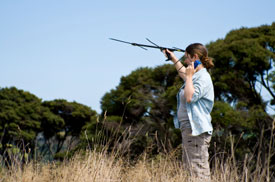
By tracking the movement, we will have a better understanding of the migration pattern of this one bird and be able to answer some important questions. With a successful installation of the PTT and if the bird does not come to any harm during its migration, we will be able to keep a record of its progress on a day to day basis both to and from its wintering habitat. Does it travel the same route to and from its wintering spot or does it return by a different route. These are some of the questions we will be able to answer through this study. Bird Studies Canada will monitor the progress and send the Friends of the Osprey regularly updates of the progress plotting its journey to the winter migration and back to Canada. The Ohio Department of Natural Resources have been conducting similar studies since the early 90’s but it is believed that this is the first of its kind to occur in Ontario and possibly Canada.
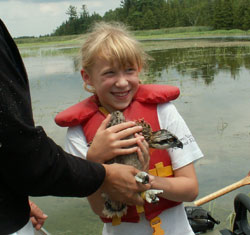
The Friends of the Osprey would like to get local school children involved to give them a better understanding of this unique and beautiful raptor. The future of this species is sometime tenuous. They were on the endangered species list because of the use of pesticides etc. but they were removed a couple of years ago. Recently declining number put them back on the watch list again. Future generations must take an interest to help Osprey. We of the Friends of the Osprey hope this study will generate, enthusiasm, and interest in the future of these birds.
Follow Us:

